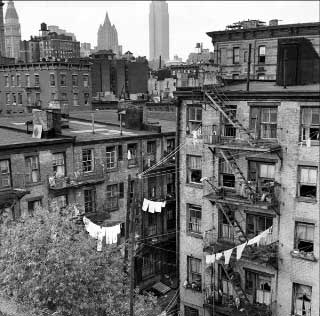

Tenements and Row Houses - cont.
In the nineteenth century, tenements came to be associated with some of the worst social ills in New York, and their inhabitants seen as the most disreputable class. Even well meaning social reformers spoke harshly about tenement residents, as a report by the Citizens Council of New York demonstrated:
The sanitary wants and the social evils of this city have become fearfully centralized in the densely-crowded tenant-house districts....the almshouse and penitentiary scarcely recognize any other persons than those long familiar with tenant-house life. We thus speak of the inhabitants of tenant-houses as constituting a class, and as being allied with the causes of sickness, pauperism, and crime.
The New York tenement is most closely associated with the Lower East Side, where the first such buildings were constructed in the 1830s when the area below Delancy Street was the poorest in the city. A tenement district also developed along the East River, where industrial development made the area undesirable for any but the poor and working class. More desirable middle and upper class neighborhoods on the east side developed further uptown around Astor Place and along Second Avenue.